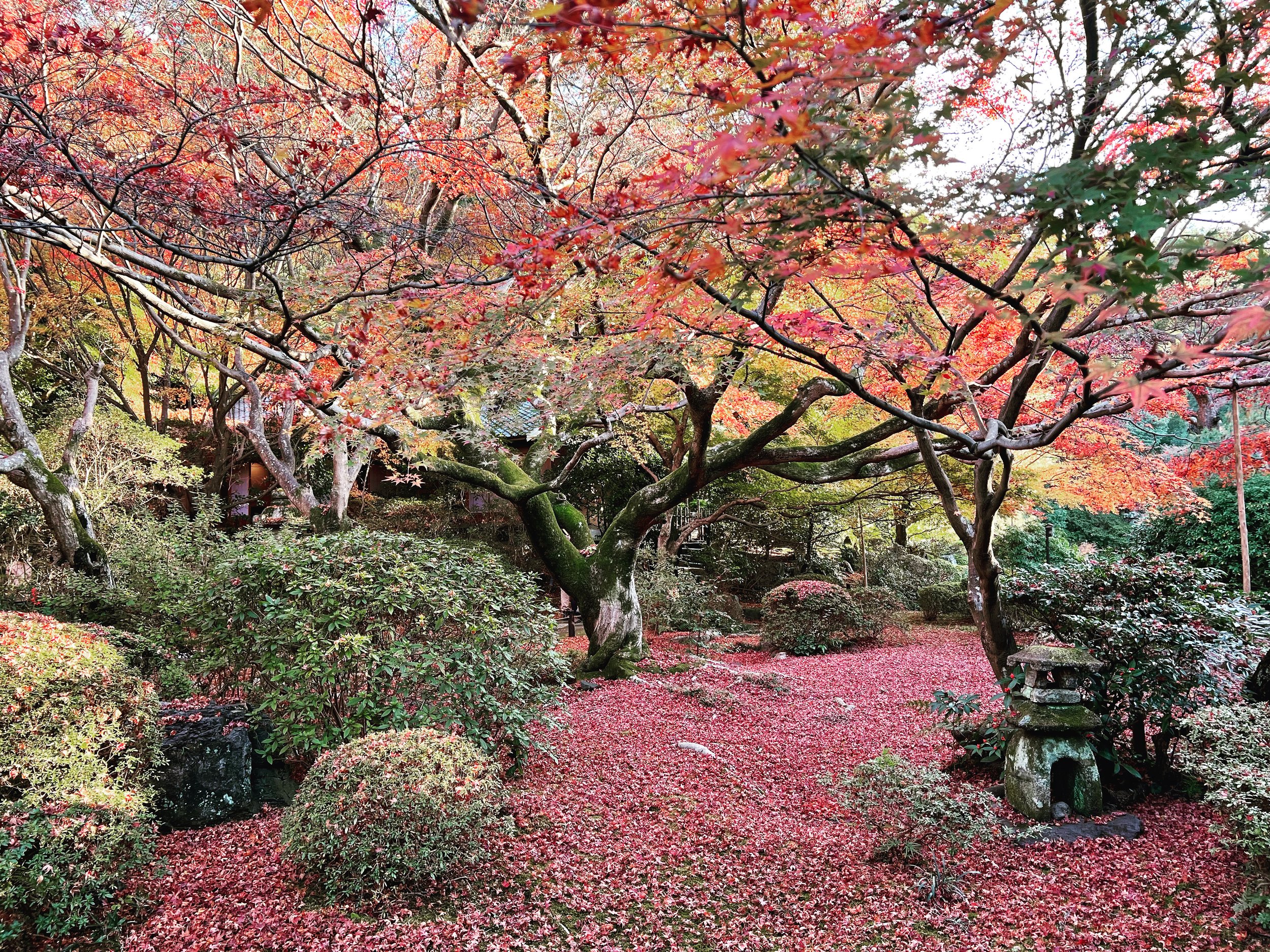Kurama to Kibune Hike: A Guide to Kyoto’s Mystical Mountain Trail
If you’re visiting Kyoto and looking for nearby hiking options, the Kurama-Kibune hike should be at the top of your list! This beautiful mountain trail connects two historic shrine and temple, offering the perfect nature escape from the city. I did this hike a couple of years ago in autumn and highly recommend it for the stunning seasonal colors and serene mountain atmosphere!
In this article, I'll share the itinerary I followed so you can get an overview of this wonderful hike, as well as practical information for planning your getaway from Kyoto.
About the Kurama-Kibune Hike
The Kurama-Kibune hike is a scenic trail nestled in the mountains north of Kyoto, connecting the little villages of Kurama (鞍馬) and Kibune (木船). Known for its mystical atmosphere and natural beauty, this 4-5 kilometer trail feels like stepping back in time as it leads you through tranquil cedar forests and past ancient temples. The hike is easy to follow and takes about 2-3 hours to complete. It is especially beautiful in autumn, when the fiery colors of maple leaves transform the mountain landscape. I’d recommend this hike for nature lovers and those seeking a peaceful escape from the crowds into Kyoto’s serene mountain scenery.
How to Get to the Start of the Kurama-Kibune Hike?
To start the Kurama-Kibune hike from Kyoto, take the Eizan Railway from Demachiyanagi Station (出町柳駅). To start from Kurama, take the Eizan Kurama Line all the way to Kurama Station (鞍馬駅), which takes around 30 minutes. The trail begins just a short walk from the station entrance.
People usually do the hike from Kurama to Kibune as it is easier this way, and you can finish your hike with a meal in one of the high-end restaurants of Kibune. But the other way around is also possible, which would allow you to finish your hike by visiting Kurama onsen (which reopened on November 1). In that case, you can start in Kibune by getting off one stop earlier at Kibuneguchi Station (貴船口駅) and taking a short bus or taxi ride up to Kifune shrine.
✨ TRAVELY TIP: You might want to take the special scenic train called “KIRARA”, which features large windows through which passengers can enjoy a wide view of the scenery during all seasons. In particular, between Ichihara and Ninose stations, there is a section of track known as the Momiji Tunnel, with about 280 maple trees over a 250-meter interval, creating a tunnel of green maple trees at the start of summer that turns into brilliant colors in the autumn season.
Hike the Kurama-Kibune Trail with Me
Arrive at Kurama Station and Pay Your Respect to Mount Kurama Daitengu
Upon arriving at Kurama Station, don’t miss Mount Kurama Daitengu (鞍馬山大天狗), the guardian deity of the area. This large, imposing tengu statue stands proudly near the station entrance, representing the mountain’s protective spirit.
The beautiful autumn colors surrounding the train station were an excellent welcome for the start of this hike. Next to the exit, you'll also see a large map of Kurama showing the hiking route and main points of interest, which you can consult before beginning this hike.
Walk Up Your Way to Kurama-dera Temple
As you walk through Kurama village, follow the path up toward Kurama-dera Temple (鞍馬寺), a serene sanctuary nestled in the mountains. You’ll first come across the Niomon Gate (仁王門), an impressive structure marking the temple’s entrance, where you’ll have to pay ¥500 as an entrance fee. If you prefer to save up some energy, you might want to take the short cable car next to the Niomon Gate for ¥200 one-way.
As you ascent, you’ll pass points of interest like the Yuki-jinja shrine (由岐神社) where you can see a cedar tree that is estimated to be over 800 years old called Kitayama sugi. The trail zigzags in the mountain, lined with tall cedar trees and stone lanterns, all the way to steep flights of steps.
Enjoy Rewarding Scenic Mountain Views and Explore Kurama-Dera
From the elevated grounds of Kurama-dera, you’re rewarded with panoramic views of the surrounding mountains, which are especially breathtaking in autumn. After taking in the view, you can explore the temple to your heart’s content. I haven’t been myself, but you might be interested in visiting Reihoden (鞍馬寺 霊宝殿), a museum where you can see exhibits on biology and geology as well as cultural exhibits of the temple treasures and other national treasures. It is open from 9:00 am to 4:00 pm, and the entrance fee is ¥200 for adults.
The trail then passes through another wooden gate and continues up several sections of steps, surrounded by beautiful autumn colors, to the top of the ridge.
Walk Your Way Down to Kibune
As you continue your hike, the next point of interest is the unique "Root Path", called Kinone michi (木の根道). This little section of the trail is known for its exposed tree roots that weave across the forest floor, creating an almost mystical pathway. It was one of my favorite parts of the hike.
You’ll then pass by different sub-temples of Kurama-dera, such as Sojo-ga-tani Fudo-do Temple (僧正谷不動堂) as well as some majestic trees with weird shapes, adding to the splendor of the walk. When you’ll see a red bridge over the Kibune-gawa River, it means you’ve arrived at the bottom of the trail!
After crossing the bridge, you can turn right and walk up the road into the village of Kibune. The village has a charming and relaxing atmosphere and is popular for its ryokan and high-end restaurants, notably known for featuring kawadoko, or patios over the rushing Kibune River below.
Visit Kifune-jinja Shrine
As you go up, on your left, you will pass the beautiful lantern-lined steps that lead up to Kifune-jinja Shrine (貴船神社). Nestled in the middle of a lush forest, this shrine is dedicated to the deity of water. You'll see a few horse statues on the shrine grounds, as legend has it that black horses are offered in times of drought and white horses in times of flood. There are also some special omikuji that reveal their fortune readings after you soak the paper on the water. And at the time of my visit in autumn, there were some beautiful seasonal momiji-shaped ema (wooden plaques used to write prayers).
If you feel like walking further, you can continue north to visit the Yui no Yashiro shrine, known as a “Shrine of love” where is enshrined the god of matchmaking, and the rear shrine of Kifune-jinja.
Getting to Kibuneguchi Station and Back to Kyoto
Once you’ve fully explored Kibune village (and perhaps treated yourself to a delicious traditional meal or a snack at one of its restaurants), it’s time to make your way back! You have two options: take a short bus ride to Kibuneguchi Station or enjoy a leisurely 2 to 3-kilometer walk along the road. I chose the walk which I found quite pleasant, with lovely autumn colors lining the path and the soothing sounds of the river flowing alongside —a perfect way to end your adventure.
When you arrive at Kibuneguchi Station, hop on the Eizan Line train to enjoy for a second time the scenic 30-minute ride back to Demachiyanagi Station in Kyoto.
Hiking Tips to Know Before Doing the Kurama-Kibune Trail
Best time to hike: You can enjoy the Kurama-Kibune hike year-round, but autumn and early summer are particularly special. In autumn, the trail comes alive with vibrant red momiji leaves, while early summer offers a lush green landscape that’s equally captivating.
Don’t forget to bring cash with you (including small notes and coins), as you'll need to pay a small entrance fee to visit Kurama-dera Temple.
Though the hike is not difficult, it’s still in the mountain area so it’s better to be properly equipped with comfortable walking shoes and hiking stick if necessary, as well as sufficient water and snacks.
If I remember correctly, you can find restrooms at Kurama station and then once you arrive at Kibune village.
Kibune-Kurama Hike in a Map
Special Recommendations in Autumn
When to Go During the Autumn Season
If you’re planning to visit in autumn, keep in mind that the peak fall foliage season in Kurama is slightly earlier than in central Kyoto, typically around mid November due to its mountain location. When I visited on November 28, 2022, some sections were already past their peak. To catch the colors at their best, you can refer to Kyoto City’s dedicated fall foliage tracking page, which provides updates on the foliage status by location. This can help you plan for the ideal time to visit!
Other Things to Do Around
If you’re looking for other things to do around, you can stop on your way back to Ninose station and visit Hakuryu-en Garden (白龍園), a tranquil mountainside garden known for its seasonal colors that is opened only on specific periods. In 2024, the Hakuryu-en Autumn Special Viewing Event will take place from 10 October to 4 December. Advanced reservation is required on the garden’s website (in Japanese only, but you can use Google Translate). I didn't visit the garden myself, but I saw it from the train windows and it seemed beautiful.
You might also be interested in visiting Ohara (大原), another small village that is a hidden gem destination in northern Kyoto (it’s on my bucket list for my next trip to Kyoto). It has some wonderful fall foliage spots in autumn, such as Sanzen-in Temple (三千院), Shuheki-en Garden (聚碧園), Hosen-in temple (宝泉院) and Horaku-en garden (宝楽園). There are a few minshuku and ryokan with onsen, such as Yumoto Onsen Ohara Sansou, Ohara No Sato and Ryoso Chatani, making it a perfect option for an overnight trip from Kyoto.
From central Kyoto, you’ll need to take a bus from Kyoto (bus 19 from Kokusaikaikan terminus, bus 17 from Kyoto station or Shijo-Kawaramachi for instance). And if you’d like to combine it with the Kurama-Kibune hike, you need to count 1h to 1h20 of transports taking the Eizan line back from Kibuneguchi station to Takaragaike station and then bus 17.
To Conclude
From the mountain views of Kurama-dera to the tranquil ambience of the Kifune-jinja shrine, I found this hike to be a wonderful experience, especially during the beautiful autumn months. I'd love to return in the future to do this hike in another season, especially in late spring or early summer to enjoy the mountain scenery in its verdant colors. Will you add this hike to your Kyoto itinerary?
Found this article helpful? Buy me a coffee. 😊
Want to stay in touch? Subscribe to my monthly newsletter (with latest articles, updates, travel tips and more...) delivered straight to your inbox. 📩
Some of the links in this Kurama-Kibune Hike Article are affiliate links. At no extra cost to you, I may earn a small commission when you click on them and make a purchase. And if you do, thanks for your support! Purchasing through these links is a great way to support Travely Notes, as this helps with the costs of running my blog..






















